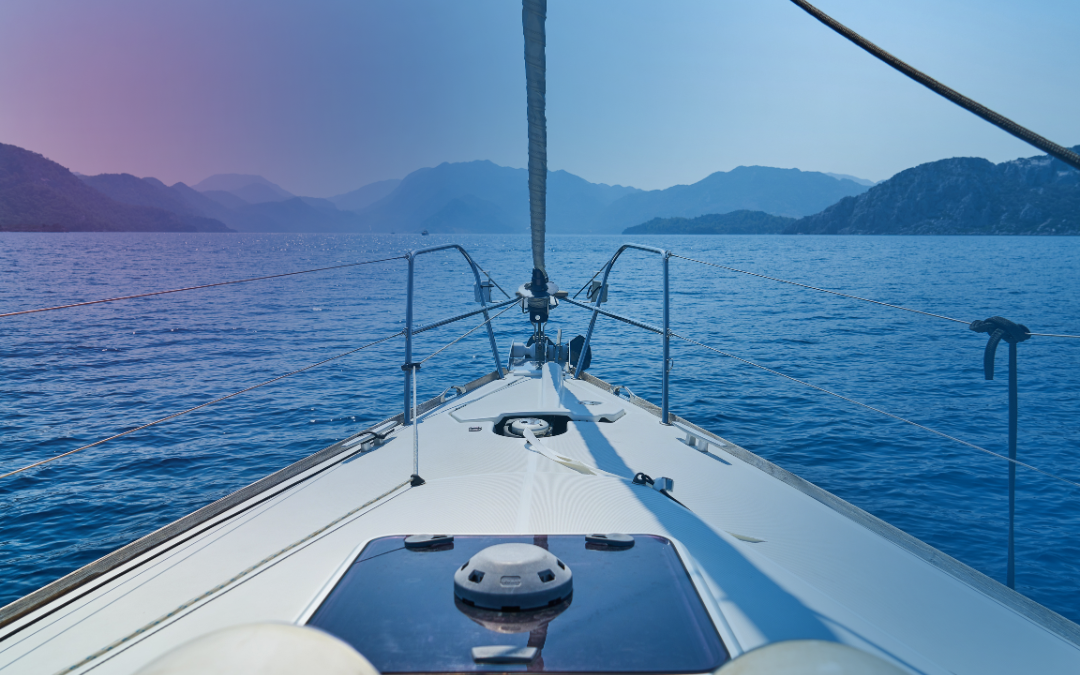I've been involved in project management for a very long time. Even the transition from high school to university was, for me, accompanied by a conscious albeit far from professional approach to managing projects. My sailing experience goes back even further. I got my first sailing license in 1989 at the age of 10, issued by the Polish Maritime Club. It was there that I accompanied my father and took my first lessons. As a teenager, I sailed purely for leisure, not competitively. I'm still far from being a professional, but I think I can now honestly call myself a competent amateur.
A sailing trip is not just a holiday – it’s a full-fledged project with risks and goals
This is tourism with a capital T. We’re not drifting from marina to marina on the Masurian lakes, ending each evening by a campfire with a beer in hand. We’re heading out to sea. Visiting Lithuania, Latvia, Finland, or Sweden requires at least two full days of continuous sailing—often even more. We’ll be sailing, and sometimes there’ll be no wind at all. Other times, there’ll be too much of it. That’s why we need to prepare ourselves and our equipment for all possible scenarios. Of course, unforeseen events can always surprise us, but the better we’re prepared, the easier it will be to manage whatever comes our way. In short, a sailing trip is a project.
From dream to project – how a sailing idea is born
The preparations begin already in the “pre-project” phase, when the first idea appears. It’s a time to roughly consider what’s possible and how the undertaking might be carried out. My ideas for sailing trips usually come to me in April, when the winter season ends. And I’m already excited at the thought of heading out to sea again. But wait… is it realistic this year? I may already have other plans, and free time is limited. Last year, for instance, I didn’t manage to fit a trip into my schedule because I chose to head for the mountains and climb Mont Blanc instead. Maybe this year it could work? Let’s run a quick SWOT analysis: What do I have? What’s missing? What are the basic chances of success? What are the risks? Until recently, I only had a small inland sailboat, not suited for sea voyages at all. But a boat can be rented. I quickly check availability. It’s there. I don’t let the opportunity slip and make a preliminary reservation. It doesn’t cost anything yet, but I now have a potential plan and timeframe for the venture. Time to officially start the project. s
Crew under sail – who makes up the team and how to engage them
I have to check the availability of my friends. I’m not sailing solo just yet—they’re the first stakeholders in my project. Naturally, the all-important family approval is already tentatively secured. I call, chat, text - they’re interested. Excellent! Now it’s time to negotiate their availability at home and at work. Some come back with a “no.” Unfortunately, not all “available resources” can be allocated to every initiative. Still, enough people are on board for this year’s sailing trip to happen, though it’ll be limited to just one week. We continue discussing what we can realistically achieve within those time constraints. Of course, much depends on the weather, which we can’t predict exactly. But based on past experiences at sea around this time of year, we agree that our goals will be to visit Bornholm and Karlskrona. Our project is purely social and recreational. Still, even in such a relaxed setting, good communication is worth the effort. So I jot down our agreements in a short message to all participants: the dates, departure and return ports, defined objectives, already-assigned roles, and the estimated overall budget. It’s a simplified version of a project charter. It will serve as our guide during preparation and throughout the trip. But that message alone isn’t enough. Not everyone knows each other. Not everyone has the same level of experience. Following best practices, we organize a pre-trip meeting; our own kind of kick-off. It’s a great opportunity for the crew to start bonding. I walk everyone (especially the less experienced) through the current plans and limitations of our project. I explain the role assignments. I try not to be too rigid about it… though I admit I sometimes am. 😉 The sea is serious business, but it’s important not to lose the excitement for the adventure ahead.
Kick-off below deck – how to prepare for a smooth voyage
We use the meeting to move straight from the opening phase into the next one: organizing and preparing. The second part of our session is devoted to collecting tasks that need to be handled, essentially defining the scope of the project. Since we’re using a rented boat, we’re spared a lot of the technical prep that would come with owning our own. But past experience has taught us to be cautious. We need to inspect the boat in advance—both on paper and in person—before setting off. Drawing on what we’ve learned, we plan the remaining prep work: securing updated maps and navigation tools, shopping for food and hygiene supplies, making sure everyone has appropriate personal gear, and more. We divide tasks, schedule deadlines, and agree on when and how we’ll check on the progress of preparations. There’s no need to go overboard with formalities, but even a simple, shared plan helps a lot, especially when everyday life gets busy. Technically, sharing it is easy these days, and it keeps us all aligned. We also write down the agreed-upon communication rules and basic principles for our shared undertaking. No one needs to know that these elements are formally called the project management plan and the team charter. We simply apply good project practices, adapted to our informal little adventure.
Packing the project on board as we make our final preparations
Everything is ready. We meet at the designated time by the yacht. Our trip is about to begin. But does that mean we are setting sail right away? Not so fast. The boat needs to be properly stowed, meaning we have to arrange the food supplies and other items in such a way that they do not fly around once we hit the waves and are easy to access when needed. We double-check the equipment and gear. Out at sea, we might not be able to fix even the simplest things, let alone buy anything. Many of us still remember that time a few years ago when we had to return from the middle of the Gulf of Gdańsk to get matches. Smokers had given up the habit and stopped carrying lighters, and at sea we cook only with gas. We also need to check the latest weather forecast. Perhaps it is worth waiting until the next morning to set out, or maybe we will leave that night. The captain makes the call. We are heading out. We are now operating on four-hour watches, so there will always be someone to ensure safe navigation while the others rest. On a small boat, the watch system does not have to be as rigid as on a larger vessel. Still, it remains a best practice at sea. Four hours is enough for fatigue to settle in. If the Baltic, as it often does, soaks us and chills us to the bone, we will happily hand over the helm and the responsibility to the next watch and dive into our sleeping bags. Unless of course it is already morning and we are also on kitchen duty that day. In that case, instead of sleeping, we have to prepare and serve breakfast. Right after that we need to clean up and get lunch ready, followed by an afternoon snack and then dinner. If we divide the work well, we might manage to squeeze in a few short naps before it is time to take the helm again. Luckily, tomorrow a new watch takes over the galley duties.
Life in shifts - the daily rhythm of a project at sea
Life at sea quickly draws us into its rhythm, so different from life on land. Watch duties, sleeping whenever there is a free moment, then back to work again. The mind takes a break from everything back home. Our trip is not a long one. Over the course of a week, we visit two ports where we stay overnight and, if we are lucky, for part of the following day. In port, the watch duties are relaxed. Everyone gets to sleep, and we often eat out. It is always worth trying the local specialties. On Bornholm, that means smoked herring in particular. Karlskrona is a city full of restaurants, including many offering international cuisine. If you ever visit, I recommend the Naval Museum, especially the section dedicated to Polish sailors who were interned in Sweden during World War II. It would certainly be worth staying there longer, but our project is defined by time. We need to return. Especially since the forecast shows that the favorable wind will not last another day. We cast off from the welcoming marina and, passing local coves and islets, head back out to sea. Watch duties again, rest whenever possible, then back to work. But watches are also time for conversation. Some of us rarely see each other on land, and some we have only just met. It has not even been a week, yet through all the shared moments, the effort, and the new experiences, we have grown closer. As is often the case with projects, only much faster, we have bonded. We arrive in Gdynia with time to spare. One last evening together, and in the morning we return the boat. Time to reflect.
A successful trip and a successful project - time for a retrospective
The project was completed successfully. We achieved the goals we originally set out to accomplish. There was still some money left in the trip budget that had been set aside for unexpected events. Fortunately, we did not need to make any emergency repairs or visit a doctor this time. So we definitely have something to celebrate a well-executed team effort. We sit down for a retrospective. We recall events from just a few days ago and reflect on the lessons we have learned. We realize that some of these insights may be useful for future trips. It is worth writing them down and keeping them for reference. After all this is not our last sailing adventure together. Oh and let us not forget about our other stakeholders it is definitely time to let our families know that we have made it back to port safe and sound.
Article written by:
Maciej Krupa
Project Manager, Senior Consultant, Amateur Sailor
PMP®, PRINCE2®, AgilePM® Accredited Trainer










